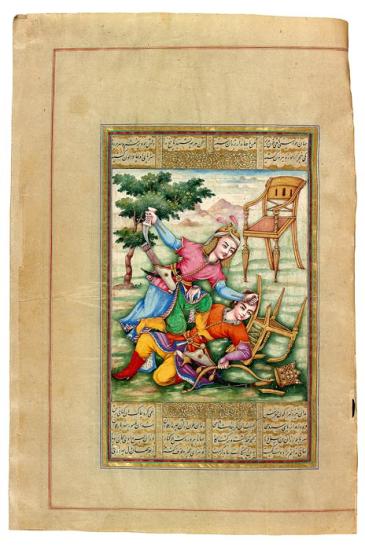
Tur Murders Iraj, His Brother
Shāhnāma (Book of Kings), in Persian
Written between 1852 and 1856 by Calī Ibn al-Ḥusain al-Kātib al-Shīrāzī, with miniatures by Luṭf Calī Khān al-Shīrāzī.
The Dannie and Hettie Heineman Collection, gift of the Heineman Foundation, 1977
This miniature appears in a nineteenth-century manuscript of Firdausī's Shāhnāma (Book of Kings), the Persian national epic. Firdausī wrote the epic—in some 50,000 couplets—between 980 and 1010. He tells the story of the mythical Persian king Feraydun, who had three sons, Salm, Tur, and Iraj. He divided the world into three parts, prudently giving Persia and the lands of the Arabs to Iraj, his youngest and wisest son. Tur and Salm were displeased that Iraj should have received the crown, sword, seal, and ivory throne of Persia and plotted against him. Iraj visited them, willing to hand over the crown, but the enraged Tur broke his throne over Iraj's head, pulled a dagger from his boot and killed him. Iraj's head was sent to the king. Years later his death was avenged by his grandson Manuchehr.
Persian poetry
The Persians loved their poetry and their poets, though the Qur˒an warned against believing their words (sura 69.41) and "those straying in evil who follow them" (sura 26.224). While Arabic was the first language of Islam and the language of the Qur˒an, Persian was favored by poets. Even Firdausī's (940–1020) celebrated Shāhnāma (Book of Kings), the national epic of Persian, was written in verse—some 50,000 couplets! Rūmī (1207–1273), the best known of the Sufi poets, put poetry in perspective when he wrote, "A hundred thousand books of poetry existed / Before the word of the illiterate [Prophet] they were put to shame!" (Masnavī I, 529). Presented here are illustrations of Firdausī's Shāhnāma as well as works by Sa˓ dī (ca.1184–1292), Hāfiz (ca. 1320–1389), and Jāmī (1414–1492), regarded as the last of the great Sufi poets. Also featured are illustrations from each of the five poems of the Khamsa (Quintet), by Niẓāmī (ca. 1141–1209), especially Lailā and Majnūn (The Persian Romeo and Juliet) and Bahrām Gūr's Seven Princesses.
